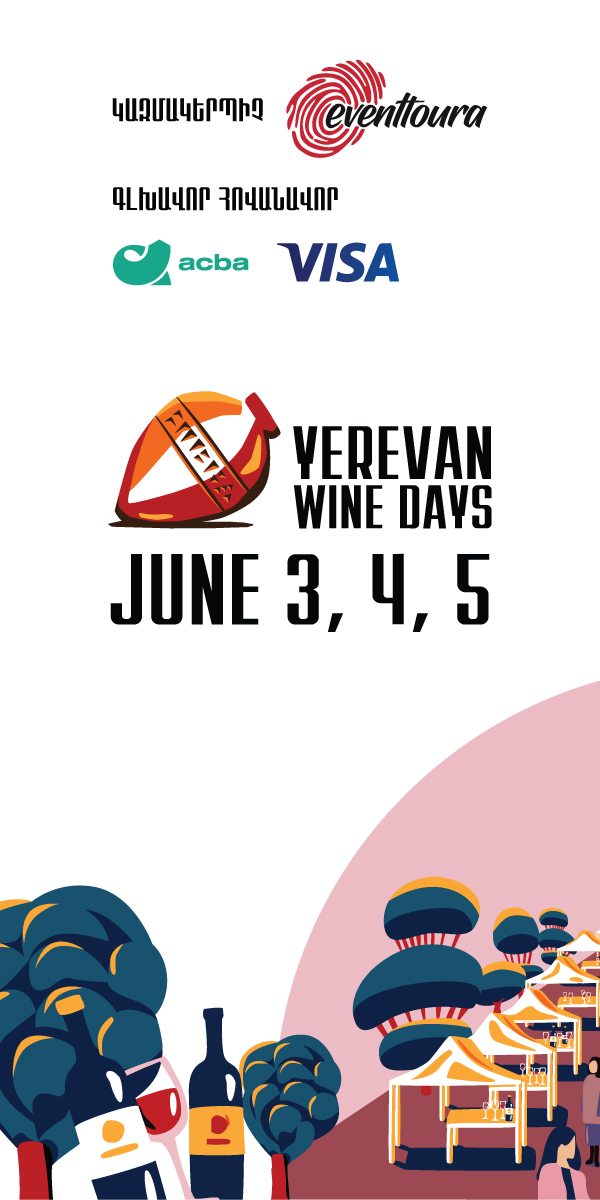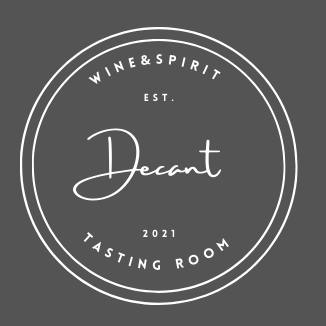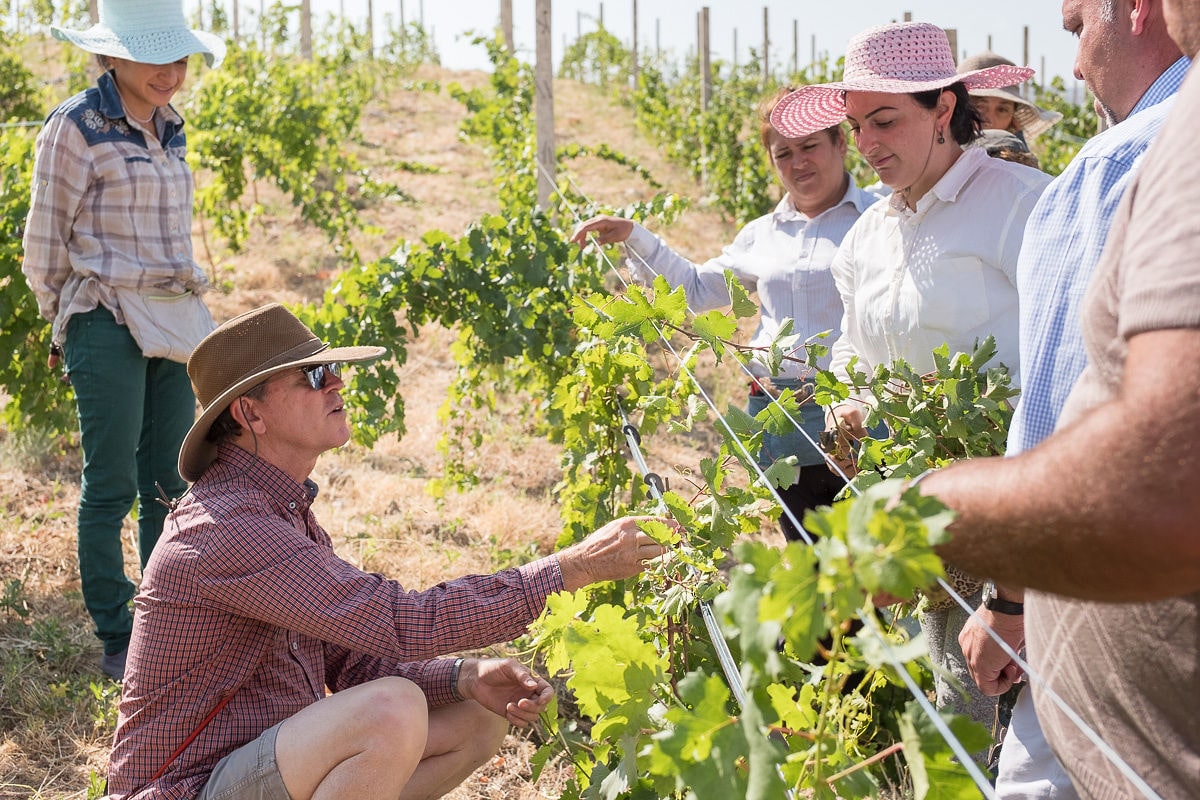Katsin: Adamyan Brothers on External Influence
- By Vicky Nvard Melkonyan
- Translated by Hayk Khemchyan
- 21 April, 2022
On September 19th, 2020, a new restaurant opened its doors to customers in Yerevan. Katsin is unlike anything Yerevan has seen based on its size, comfort, menu, and service. Brothers Mher and Gevorg Adamyan conceived the concept, and by owning other cafés and restaurants around the city, have become leaders in the Armenian food scene.
In the process of completing each new project, the brothers share responsibilities. Mher creates one-of-a-kind menus and sources ingredients while Gevorg has an affinity for interior structure and design. It’s safe to say their second to last project is a success–Katsin was fully booked from morning to late evening in the first week of opening.
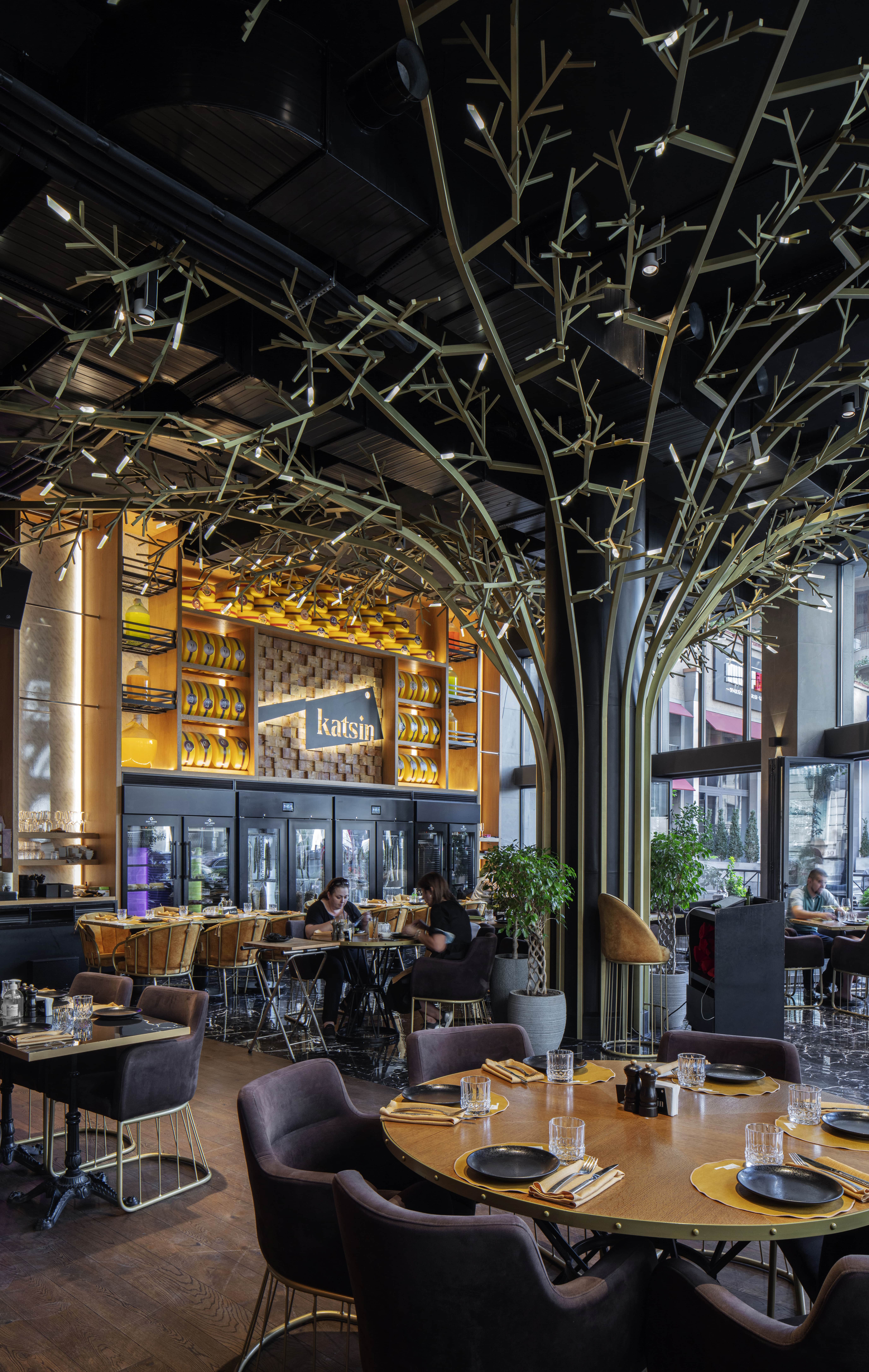 The interior “tree” references the handle of a katsin or axe at Katsin. Interior design by Mikael Karsyan, IMAGEMAN Interior & Architecture. Photo Credit: Sona Manukyan and Ani Avagyan.
The interior “tree” references the handle of a katsin or axe at Katsin. Interior design by Mikael Karsyan, IMAGEMAN Interior & Architecture. Photo Credit: Sona Manukyan and Ani Avagyan.
How did you end up in the restaurant business?
Gevorg: Back in 2011, we opened our first Tiziano café in Piazza Grande Business Center. Initially, we had planned to have the café open until 6 o’clock. But later on, we saw that there was more demand. The hours changed to 8 p.m. and then until 11 p.m. Soon we realized that we needed good pastries to complement the coffee. So we invited Philip Mark, a world-class confectioner, to come to Armenia. We collaborated with him to create unique pastries that are licensed and belong to us only. In 2013, we opened the second Tiziano café on Northern Avenue.
We also wanted to have a restaurant which would provide quality food. That was our Food on Wood restaurant. Around that time, my brother Mher traveled to London to study at Le Cordon Bleu culinary school. He also traveled to Italy, Japan, and Thailand to learn about their culinary traditions and practices.
Smoking Chef steakhouse opened next, where we created the necessary conditions for curing meat. This restaurant quickly became popular, and in 11 months, we sold it as a profitable business. Our idea was to take on new projects such as Katsin.
How is this project different from the previous ones?
Gevorg: Katsin is a special project. In itself, it contains all the lessons we have learned along the way. I do not believe there is anything like it in Armenia. We serve breakfast, lunch, and dinner until midnight. We have anticipated that people would like to stay longer in this restaurant than usual and we have taken great care in the details regarding the decor, the lights, and the music. We are incredibly proud of obtaining the license to create convenient passages, ramps, and restrooms for people with special needs.
Walking in, the customers see all the products we make here, such as meats and cheeses. The kitchen is also open so that the guests may observe how we handle our products.
Another way Katsin is different is its size and area. This place is [vast], and it allows us to serve different kinds of food from different areas of the restaurant. For instance, the right-hand side from the entrance is set up as a café. The inner part is a restaurant where customers can see the kitchen. Upstairs we have slightly more enclosed areas for larger groups of people. There is also a balcony that looks out at an old Yerevan building, the Hripsimiantz school founded in 1920. We have had to work hard to make the yard more vibrant and pleasant with flowers and bushes. We installed water systems, and now we have beautiful green lawns outside the balcony.
What was it like completing the project in times of a pandemic?
Gevorg: The problem with this was the uncertainty. No one knew what was going to happen the next day. Usually, when we took up a project, we had our vision and a fixed plan, but with coronavirus, we couldn’t plan anything. I think the pandemic has affected the restaurant business [tremendously]. Restaurant owners had to let go of some workers simply because they couldn’t pay their employees.
What inspired Katsin and its name? What is the concept behind it?
Gevorg: We needed the name to be laconic and easy to pronounce, something Armenian that you would not mix with any other name. Katsin is also a philosophy for this particular restaurant. Our menu offers large dishes such as whole lamb or whole piglet. And they are sectioned using the butcher’s cleaver or the “katsin.” The entire concept is based on the connection to nature. For instance, we use wood for cooking the dishes instead of coal. We avoid grinding meat using a food processor. Instead of acquiring chicken breasts, we buy a whole chicken, and with any meat we use–our goal is to minimize waste by putting every part of the carcass to use.
Why do you cure meat in-house?
Mher: When I was in Southern Italy, I saw how the Italians utilized the pork skins; they would make chips and simply serve the pork with them. In Armenia, we do not fully use what we have. Nature has created these animals, for instance, a pig, and we should take advantage of all its parts instead of wasting them. The bones go into a broth; the meat on the cheeks makes great jerky. Even the meat on the head can become a tasty soppressata.
So what we do is we pay farmers to raise the stock without artificial feed to grow slowly and more naturally. Then we begin to salinate the meat, add certain spices and hang up in the perfect conditions of humidity and heat which mimic the Italians’ conditions in their sheds and basements where they make their homemade meat assortment.
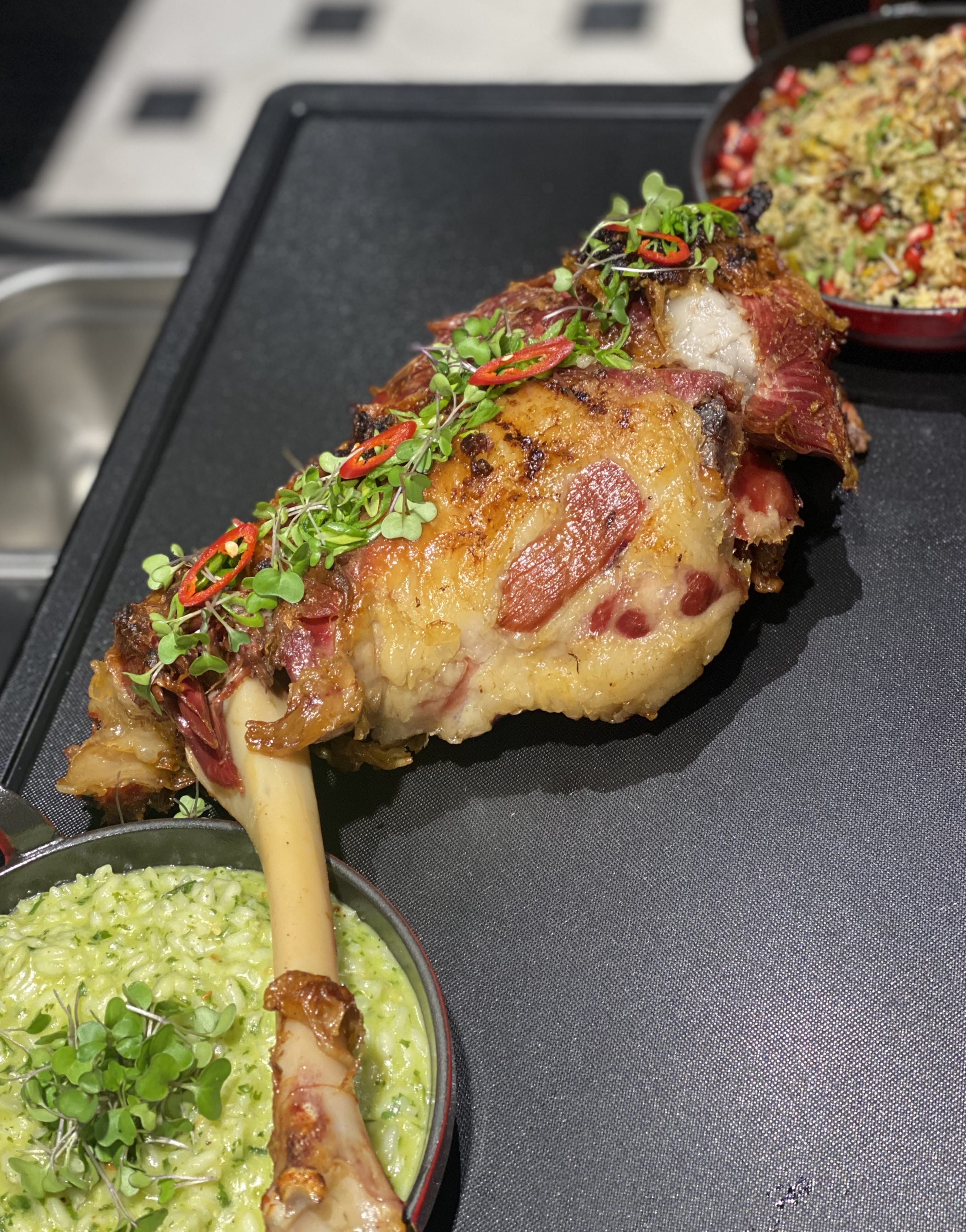 Charcoal roasted leg of lamb served with couscous, vegetables, and peas | Photo Credit: Katsin
Charcoal roasted leg of lamb served with couscous, vegetables, and peas | Photo Credit: Katsin
How would you describe your menu?
Mher: To discuss that, I will first have to uncover the feeling of “tasty.” Its components are taste, smell, appearance, and texture. We can also add a fifth factor which I call “the external influence.” The environment, the service quality, the weather, the mood, and so on make up the external influence. For instance, the khash (Armenian soup made from cow or sheep parts) may be amazing by itself, but you cannot eat it in summer. So what we want to do here is create a perfect combination of all these factors to satisfy those who choose [to dine with] us. Concerning the menu, we are proud of our lamb dishes, some cooked slowly in pork fat for over 48 hours but never barbecued. This is novel and different from other restaurants. In addition, we have a great selection of cured meat and local cheeses and the South American and Japanese-style raw fish and seafood assortment is something we’re proud of.
Who is responsible for the wine list in the restaurant? And what are your criteria?
Mher: On a large scale, importers dictate our wine list. Whatever they bring into the country is what we have on the table. It is also imperative to compete with other restaurants and their wine lists. On a smaller scale, [our wine list reflects] the dishes we serve and people’s preferences.
What are current restaurant trends? How has the pandemic changed the restaurant culture so far, and how do you see the trajectory moving forward?
Mher: In the recent past, competitors did not pay attention to each other. But now, there is serious competition caused by the lack of customers. So most restaurants in Yerevan are now taking their marketing seriously. The quality of the restaurant culture, in my opinion, is quickly changing. Some places invite chefs from abroad to create a menu for them. We finally see all the components of “tasty” come into play. Portion sizes are becoming smaller, plates are decorated more beautifully, and I think restaurants outside of Yerevan will also change for the better in terms of the “external influence.” In the next five years, I believe outdoor restaurants in the region will have higher quality, better service, and more sophistication than there used to be.
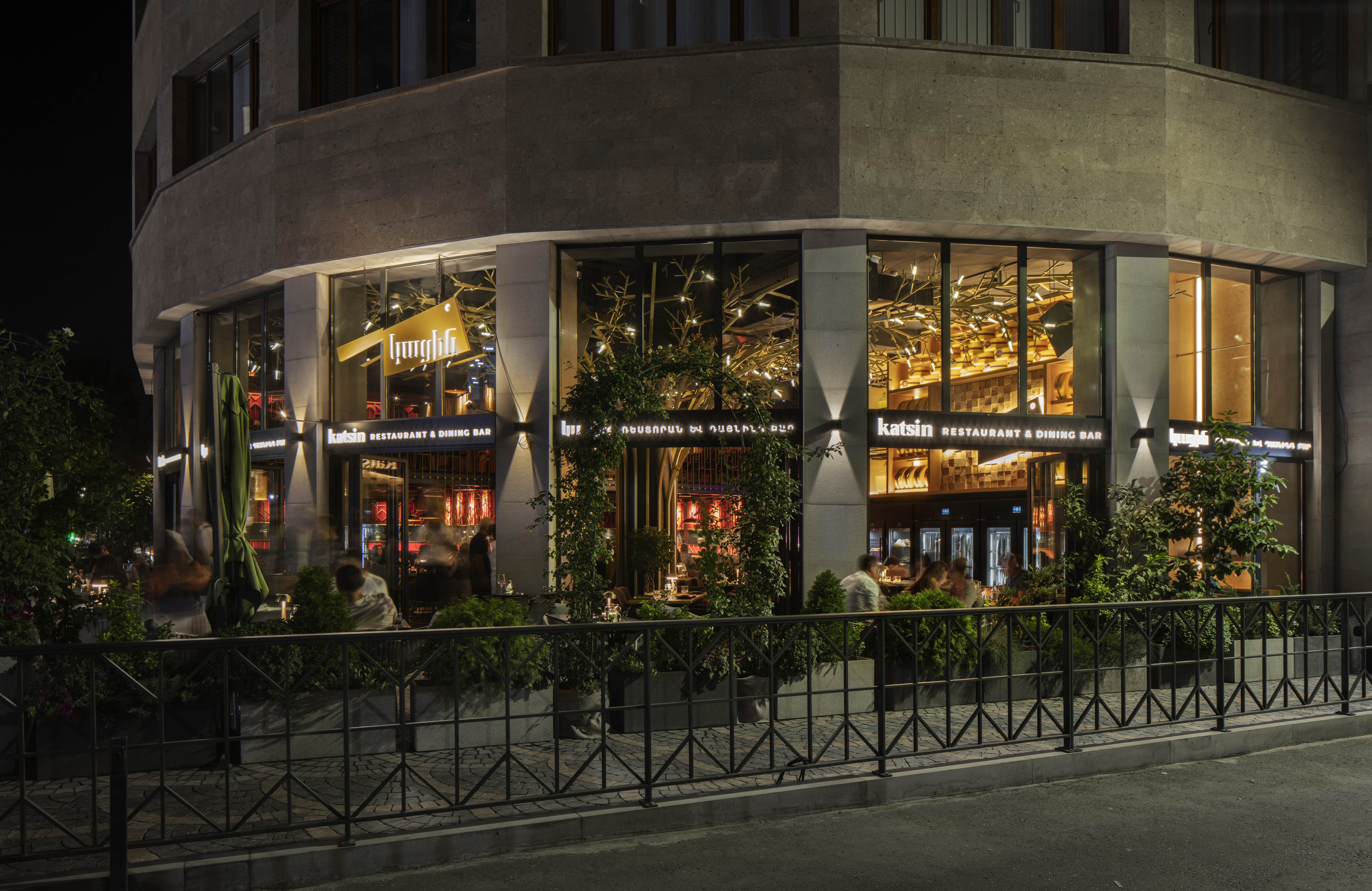 Katsin lights up Yerevan’s throbbing nighttime city center through its panoramic windows. Interior design by Mikael Karsyan, IMAGEMAN Interior & Architecture. Photo Credit: Sona Manukyan and Ani Avagyan.
Katsin lights up Yerevan’s throbbing nighttime city center through its panoramic windows. Interior design by Mikael Karsyan, IMAGEMAN Interior & Architecture. Photo Credit: Sona Manukyan and Ani Avagyan.
What’s your best advice to someone who wants to open a restaurant?
Mher: Study, read books, learn everything you can about food and drinks and never stop learning. Once you get into this sphere, you have to keep up.
-
21 December, 2022
-
15 December, 2022
-
30 November, 2022
-
26 August, 2022
Similar Stories
-
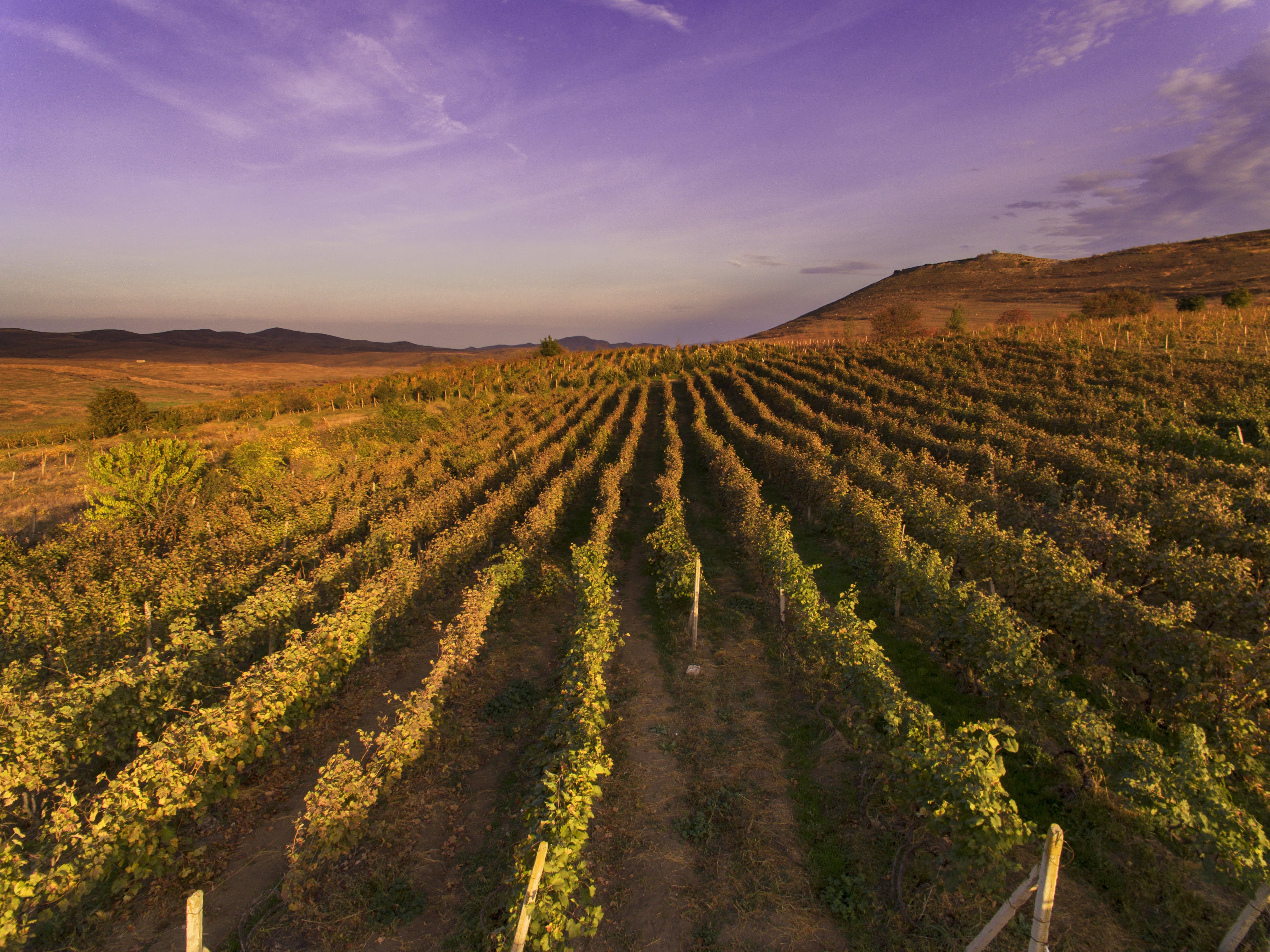 21 April, 2022Rows of vineyards stretch along the fraught border between Armenia and Azerbaijan, and now and then, they even take a bullet. For the community of Berdavan in the province of Tavush, 125 miles (200 km) from Yerevan, many inhabitants make their living exclusively off of these vineyards. Despite the unstable border and deadly crossfire, the vineyards are cultivated with care and what they yield is used to make quality wine.
21 April, 2022Rows of vineyards stretch along the fraught border between Armenia and Azerbaijan, and now and then, they even take a bullet. For the community of Berdavan in the province of Tavush, 125 miles (200 km) from Yerevan, many inhabitants make their living exclusively off of these vineyards. Despite the unstable border and deadly crossfire, the vineyards are cultivated with care and what they yield is used to make quality wine.


